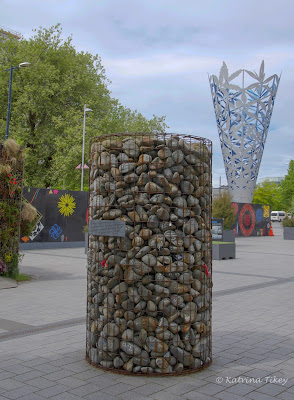We wondered what the city centre would be like now. How had it changed? We were staying nearby so decided to see it for ourselves. I've seen photos of the '185 chair memorial' and thought that would be a good place to start - to begin by paying our respects.
As a temporary memorial for the first year anniversary of the earthquake local artist Peter Majendie painted 185 chairs white. The inspiration for this came from Vincent van Gough's painting of empty chairs, which represented their owners' different personalities.
The memorial has become a major tourist attraction and can be seen at a site that's diagonally opposite the CTV Building site (where 115 people died). It was very moving standing there and seeing so many different empty chairs. There was a student's chair, a baby car seat, school chair, stool, camp chair - just so many of them. It was so sad.
The central city and eastern suburbs were the most severely damaged. The magnitude 7.1 earthquake that had occurred five months before, on the 4th September 2010 had weakened buildings and infrastructure. When the February earthquake struck, although it was smaller on the Richter scale, much more damage occurred since the previous quake had weakened things.
The iconic Christchurch Cathedral's spire and part of its tower were destroyed, the rest of the building was badly damaged.
The Cardboard Cathedral is made from 96 cardboard tubes (reinforced with laminated wood beams). Other materials used were timber and steel. It has a polycarbonate roof ( a strong thermoplastic material that's lightweight and able to withstand low and high temperatures). The walls are formed from eight shipping containers. There are two inch gaps between the cardboard tubes where light is able to filter through. The cathedral appeared to be light and bright when we visited, despite it being a dull day.
Although I've seen pictures of the cathedral after the earthquake, it wasn't until I stood outside the fence staring at the broken ruins, with weeds growing all around, that the reality struck me. It was haunting.
There's still an ongoing debate whether to demolish the cathedral and build a new one or to repair it.
Something else that struck me, was the noise. The construction work that seemed to be in every direction was constant and loud.
Many artworks have been made to beautify the area. In front of the fenced off Cathedral is a whare with plants growing on its walls and over the roof. It adds a splash of colour, and perhaps the new growth is symbolic of life going on.
A stone cairn is an eye-catching feature standing in the Square.
4,000 people brought the stone cairn to the Cathedral Square in 2010 to protest against the sacking of the Environment Canterbury councillors and the appointment of commissioners in their place.
There seemed to be a lot happening - the sound of construction, people commuting, tourists wandering about, tram tours, cyclists and temporary food carts doing business. It was a hive of activity.
Nic-named 'The Road Cone City' - it's estimated there are at least 10,000 fluorescent road cones in the city at any one time.
Bernie wonders why so much effort goes to restoring the old buildings. Wouldn't it be easier and cheaper to demolish it and build again?
The Glass Pavilion is built from industrial waste materials and is topped with a disorderly nest-like timber roof. The handmade glass bricks change colour as light passes over them. When the sun fades the structures changes into a beacon of light. It offers shelter but is also open to the elements.
The Container Mall (originally called Re:Start) is a temporary mall built from shipping containers. When we wandered through, the air was full of delicious smells from the various food carts. It seemed a popular spot - people sitting around cafe tables chatting and being entertained a group of children dancing.
Rebuilding a broken city.
I'll end this post with a touching poem pinned to the noticeboard by the '185 chairs' memorial.
A Blessing For The Broken Hearted
There is no remedy for love but to love more
-Henry David Thoreau
Let us agree
for now
that we will not say
the breaking
makes us stronger
or that it is better
to have this pain
than to have done
without this love
Let us promise
we will not
tell ourselves
time will heal
the wound
when everyday
our waking
opens it anew
Perhaps for now
it can be enough
to simply marvel
at the mystery
of how a heart
so broken
can go on beating,
as if it were made
for precisely this ...
as if it knows
the only cure for love
is more of it
as if it sees
the heart's sole remedy
for breaking
is to love still
as if it trusts
that its own stubborn
and persistant pulse
is the rhythm
of a blessing
we cannot
begin to fathom
but will save us
nonetheless.
-Jan Richardson

























A well-written post, Katrina - a tribute to the spirit of Christchurch.
ReplyDeleteSadly most of the old buildings have been demolished - with no intention of rebuilding them. In the days following the February 2011 quake many were hastily, & mistakenly, taken down without a full inspection simply because they were seen to be "at risk". What few we have left - those that are being restored, are critical to the esence of Christchurch.
ReplyDelete